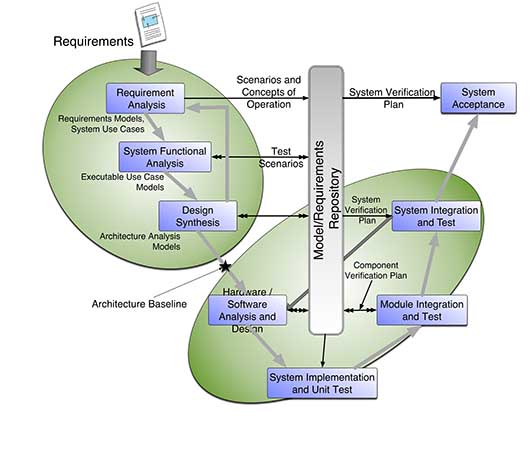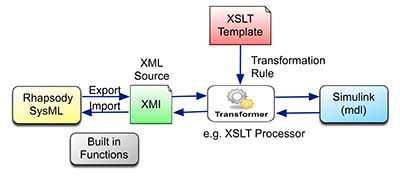Transport

Platform Independent Model Driven Architectures for Future Vehicle Systems
Summary
This research has bridged the gaps in a Model Based System Engineering (MBSE) workflow through the use of our special model transformation tools. The goal has been to create an integrated workflow tool chain to facilitate integration of various subsystems and verification of the overall system performance to meet a set of desired system requirements. The research led to an implementation in a model-based representation that encompasses “real” system hardware-in-the-loop components to verify the effectiveness and capability of the development platform. Significant breakthroughs have been achieved in the developed model transformation processes that make this possible. An test case example applied the process to the development of subsystems for a vehicle system.
Additionally, the project has demonstrated how model driven architectures coupled with open systems architectures can be used to support future vehicle designs by driving the system architecture from a platform independent perspective. We have clearly shown that it is significantly easier to design and re-use validated system components and manage the ever increasing system complexity of the overall vehicle design.
Model-based Systems Engineering
Model-based systems engineering (MBSE) is the formalised application of modelling to support system requirements, design, analysis, verification and validation activities beginning in the conceptual design phase and continuing throughout development and later life cycle phases.

A model is an approximation, representation, or idealisation of selected aspects of the structure, behaviour, operation, or other characteristics of a real-world process, concept, or system (IEEE 610.12-1990), i.e. an abstraction.
A model usually offers different views in order to serve different purposes. A view is a representation of a system from the perspective of related concerns or issues (IEEE 1471-2000).
Aims & Objectives
The goal is to provide processes, tools and technologies to support optimisation of a complex system involving different specialist domains. New techniques will be developed to enable distributed model based simulations to become an integral part of an advanced collaborative environment. Management of non-heterogeneous data derived from a wide variety of sources will enable multi-criteria decision analysis to be performed for complex systems.
An example of a transformation bridge is the interface between the abstract modeling language (SysML) and a domain specific language, in this case between Rhapsody and Simulink. Here the platform independent model (described with SysML) can be transformed into platform independent or platform dependent Simulink models as shown in Fig. 2. The transformation process also allows platform specific details to be combined with the abstract model, resulting in a targeted functional model that supports activities such as trade-off analysis, verification, and validation. Such activities will generate design changes and insight that must be reflected back to the platform independent model, allowing information to be disseminated outside of the domain experts and supporting the through life management of the system. To achieve this, the transformation bridge must provide a complete mapping between individual elements of both modeling languages.

Simplified Process for the MBSE Transformation Bridge
Benefits
This iNETS project has the potential to radically transform the transport and related manufacturing/supply chain by providing new capability to integrate new technologies into vehicle systems (rail, tram, coach, automotive and heavy goods vehicles) through life. The proposed approach will make it significantly easier to design, build and re-use validated system components independently of the vehicle architecture thus managing the ever increasing system complexity arising in future vehicle systems.
Adopters will become more agile in terms of incorporating sophisticated technology and thus adapt to changes throughout a product’s lifecycle. From a commercial perspective this will provide a competitive edge to the companies adopting the model-based systems engineering approach by facilitating early system verification and testing with subsequent risk reduction and compliance with stakeholder needs.
There are many benefits to using the MDA approach, with the most important being:
a) An architecture based on the MDA is always ready to deal with yesterday’s, today’s and tomorrow’s “next big thing” (i.e. hardware independent).
b) The MDA will make it easier to integrate applications and facilities across middleware boundaries.
c) Significant risk reduction
d) A key to trade space optimisation
This is a multi-disciplinary research project involving computational science, human factors and systems engineering and builds on our extensive experience of distributed grid based systems (e-Science) and real-time modelling & simulation.
Research Sponsors



Want to know more?
Contact r.s.kalawsky@lboro.ac.uk, 01509 63 5678
Download a pdf containing this information
